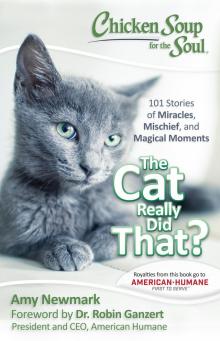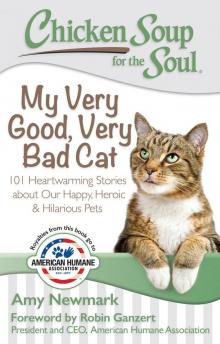- Home
- Amy Newmark
My Very Good, Very Bad Cat Page 5
My Very Good, Very Bad Cat Read online
Page 5
His wily mother had evaded capture for years and is responsible for thousands of cats being born, generations and generations of cats, all in the abandoned and crumbling barn of a patch of farmland, parceled into smaller and smaller lots until all that was left was her barn surrounded by a crop of red brick houses. I often wonder why she finally gave herself up. Whatever the reason, she surrendered quite easily in the end, with Watson squirming and dangling from her mouth. We celebrated the capture of this last feral female along with her last litter from that old, rotting barn. She seemed to make peace with it and was placed in a home, where she seemed to enjoy kibble and an indoor life sitting on a cushion by the window. The kittens, one by one, also found loving homes — all, that is, except Watson.
As kittenhood — where much is forgiven — became adulthood, what to do about Watson became the daily question. He was a bad seed, my staff said. But not in the hissy, scratching, bitey kind of way — though under certain circumstances, he would judge that sort of response to be appropriate. He was bad in the “I-know-it’s-bad-and-I’m-doing-it-anyway” sort of way.
“He could just live here forever…” I said tentatively, knowing that it was my turn to take the unadoptable cat home.
“Yes, but he’s so disrespectful.”
“He’s not disrespectful; he’s just young,” I countered. But it was true. Our other clinic cats, well into their teens and prized for their respectfulness, were tired of this now two-year-old pushing them out of their resting spots only to get up himself seconds later. They were tired of him attacking their tails, stealing their toys and kicking litter everywhere. And the office staff was tired of him hanging up on clients, deleting computer entries as they typed, taking their pens, breaking open bags of food and treats, knocking things on the floor, and ripping up books and paper. He ran full throttle to the sound of a printer in action, to the door at each tinkle of the bell, to the phone when it rang, and to the water running in the sink.
He seemed to be everywhere all at once, and so skilled as a climber and thief, it was impossible to completely Watson-proof the clinic, already proofed as it was for cats. And I will admit I was tired of tripping over him, which I did at least six times a day. I was tired of him clinging around my leg as I headed to my next appointment. I could not remember the last time I’d worn a skirt or dress to work.
“Did you know he’s fond of socks?” someone said.
“Yes, he tries to pull them off me when I sit at my desk,” I said.
“He steals them from my gym bag.”
“Oh. Is that your sports bra on the floor there?” I asked.
“Oh, yes, he likes those, too.”
“What else has he got there?” I asked.
“Never mind. Watson, give me that. Stop running. Give it up.”
I will not say we did not love Watson, just that he was far too involved for a clinic cat.
So Watson came home with me. And this opened up a whole new set of possibilities for Watson to hone his badness, and particularly his skill as a thief.
At first, there was a settling-in period when my two resident cats, Merry and Gus, and two large dogs, Penny and Dan, had to get used to Watson’s presence and wildness, his burgeoning and undeniable superiority.
They’d look at me one after the other as though to ask, “Mom, what are we going to do about Watson?”
Once all had agreed upon his top cat/dog status, which took surprisingly little time to establish, he began to systematically take over every prime resource available, and then he began to scout for items worth thieving.
Pens continue to be a favorite, and he especially loves the sound they make rolling down the hall in the middle of the night. Penny, our yellow Lab, loves to present us with a dishtowel tugged off the stove door or a shoe when we come home. And this may be how Watson became interested in towels, slippers and even the odd shoe. Why pull pink fiberglass out of the walls in the basement when all these other delectable items are scattered about a house full of kids?
The kids would ask me one after the other when they could not find a pair of socks or mitts between them: “What are we going to do about Watson?”
When the dolls and toys were put away for good, he began to steal jewelry and underclothing. And once again they asked, “What are we going to do about Watson?”
It’s been interesting living with a cat like Watson. The kids learned to keep their doors shut. Gus escaped and ran away. And then Louis, a gray Tabby, moved in, and Watson loves him, so they co-cat this house. He has taught Louis how to open doors and to thieve. Louis’s favorite find is a cloth doll with long black wool hair or any large, damp towel that he can drag down the stairs. Watson’s is, of course, any pair of socks. Over the years, these two partners in crime have grown old together and are more likely to be found curled up in a gray-and-white-spotted swirl than stealing pens, socks or earrings. And nobody asks, “What are we going to do about Watson?” They can usually be found in their spot on the couch, sleeping with Louis’s doll and Watson’s socks.
~Carol Teed
Our Family Christmas Card
Fun fact: In Icelandic folklore, a person who doesn’t have at least one new item of clothing for Christmas will be taken by a horrible Yule Cat.
Last year, Art and I decided to dress in matching holiday sweaters and, along with our three cats, snap a “family” Christmas picture. Mailing it out as a Christmas card to relatives and friends sounded like fun, especially considering all the kids’ pictures we’ve received over the years. We’d accumulated many cute cards to display along with hideous ones of babies, animals and people. This card, including our feline family, would be payback. It was a good idea, but not so easy to pull off.
Our first challenge was finding two identical holiday sweaters we both liked and would wear while taking our picture. We shopped in the men’s department of a large store for a better selection of colors and patterns, and because Art wouldn’t be caught dead in women’s clothes.
The first sweater to catch my eye was navy blue, trimmed in white, displaying a beautiful wintry snow scene. It was a frontrunner. We continued our search, looking for something more colorful. The next one we liked was a white cable turtleneck sweater. Not colorful at all, but a perfect winter sweater. The final sweater in the running consisted of a red background with two white reindeer on the front, surrounded by a swirling snowflake design. We agreed this was the one.
Now the search for our sizes began. There were many in large sizes, less in medium and very few in small. After looking through hundreds of sweaters, I couldn’t believe we found a small petite in the men’s department for me. “A Christmas miracle!” I shouted loudly. Embarrassed, I hid behind a stack of sweaters.
Next, I stopped at the Dollar Store and picked up three red bows. I planned to tie them around our cats’ necks as bowties. It would be easier than trying to keep small Santa hats on their active heads.
Picture day finally arrived. Art set up his camera and timer in front of our living room couch, while I corralled the three cats into the room. We wore our matching sweaters; the cats wore their red bows. If only it were this simple. Art held Daisy, our youngest striped kitten, on his lap while I held Oliver, a seven-year-old, gray-and-white male, and Ginger, a twenty-four-year-old tuxedo cat.
Daisy was the first cat to get fidgety and run away. While Art was chasing after her, the timing device went off. I was left sitting there with two cats on my lap in a firm grip with a surprised look on my face. Our second attempt was even worse. The camera didn’t work, and when Art left the couch to fix the flash, it went off unexpectedly. This picture showed the tail and rear end of Daisy, and Art’s crotch. Not a great family image for a Christmas card.
In the next shot, Oliver and Daisy had both run off, leaving me with poor old Ginger, who was happy to be sitting on my lap, or any lap, sleeping. By our seventh attempt, we decided to give up on the cats and take only our picture. We were both tired from the constant running back and for
th chasing cats and adjusting cameras, and perfectly content sitting back and relaxing on the couch. I’m surprised we didn’t fall asleep like Ginger.
Our final picture turned out well. We shot it holding photographs of our three cats. I was elated just to be smiling and not trying to restrain a runaway cat.
~Irene Maran
My Goofy Cat
Fun fact: Cats, camels and giraffes are the only four-legged animals that walk “contralaterally.” The right front leg and the left back leg move forward at the same time, and then the left front leg and the right hind leg move forward together.
Scooter Versus the Vacuum
Fun fact: Some cats can be “desensitized” so they won’t be scared of the vacuum, but this type of training is more successful if done when they’re still kittens.
Scooter was fearless. A three-legged calico, Scooter had to fight from birth just to make sure her mother didn’t decide she was too injured to live.
She’d puff herself up enough to scare cats twice her size — including her big brother.
She’d challenge visiting dogs — and even though she couldn’t outrun them, she’d outsmart them. She’d jump just beyond their reach, and then dangle a paw or tail to taunt them.
She’d look at the vet with a Clint Eastwood gaze that seemed to say, “That all you got? I lost a leg, bub. It was cut off by my mom’s umbilical cord at birth. You think you can scare me with your feeble shots and banana-flavoured penicillin?”
Even car rides didn’t faze her.
There was only one thing she was ever afraid of — the vacuum.
Other noises didn’t bother her, even sudden noises. She’d cuddle while I watched hockey games and didn’t flinch when I cheered for my Canucks. But the vacuum sent her scurrying for cover. Even when the vacuum wasn’t anywhere near her, she’d hear it and hide. If she saw it coming out of the closet, she’d bolt into the next room.
If Scooter was Super Cat, the vacuum was her kryptonite. The vacuum was her arch-nemesis. She didn’t just fear it; she loathed it.
When she was five or six, some days when it started, she’d watch the machine for a few moments before she ran to hide. As crazy as it seems, I began to suspect she was plotting its demise. Then, one afternoon, Scooter saw her big chance.
The vacuum was turned off, sitting at the foot of the stairs. Scooter was in my office. She poked her head out to look at it. When she saw that it wasn’t moving — or hadn’t noticed her — she slowly approached it, like she was stalking a bird. Then, without warning, she attacked. She took her paw and hit it once, twice, three times. I couldn’t believe what I was seeing. She saw me watching and made sure I didn’t miss her victory. She swatted the vacuum’s base again and again and again. I wasn’t sure whether to laugh or applaud.
If the vacuum had been a living creature — or a couch — her claws would have eviscerated it. But the vacuum was a vacuum and emerged unscathed.
This didn’t lessen Scooter’s triumph.
She circled again and sliced at it again — striking the metal base to make sure the vacuum got the message: “This is my house.”
After I was sure Scooter had finished celebrating her victory, I finally turned on the machine. It roared to life. Scooter didn’t budge. The three-legged, eight-pound calico looked at the vacuum with a homicidal gleam in her eyes that made one thing very clear: “I own you.”
Scooter never ran from a vacuum again. Instead, whenever a vacuum appeared, she’d watch it carefully to make sure it never forgot for a moment that she was the boss.
~Mark Leiren-Young
More Fiber, Please
Fun fact: Cats that develop compulsive disorders, such as eating fabric, usually do so when they are less than two years old.
My cat Lilo and I are both fabric lovers: I’m an amateur seamstress, and Lilo devours cloth with as much gusto as if it’s tuna.
The Roman shades I fashioned for my window, the duvet covers and pillowcases I sewed for my bed, the first quilt I ever made, my custom pair of yoga pants — all have fallen victim to Lilo’s ravenous appetite. Once she started gnawing on a baby blanket while I was still guiding it through the sewing machine!
The first hints of Lilo’s strange tastes came soon after I took her in. I’d found her in a parking lot on one of those steamy August afternoons when heat radiates in visible waves off the pavement. She was a young thing, probably three months old, and tiny — just three pounds of scrawny muscle. I lured her inside with kibble and then put up notices around the neighborhood and on Craigslist about a found kitten. No one came forward.
A few days later, Lilo was curled up in my lap, purring and licking the hem of my T-shirt. “Isn’t that cute?” I thought. “She’s trying to groom me.” I petted her and returned my attention to the magazine I was reading.
When I looked back down, Lilo had eaten a nickel-sized hole in my shirt. “You are an odd little cat,” I said, but shrugged off her behavior as bizarre kitten antics.
A week or so later, I gave Lilo a fabric mouse toy. You know the ones — filled with batting, with squiggly little tails to make them look more like the real thing.
I set the toy in front of her. She pounced, then sank her teeth in and started to wolf it down. When I realized that she was literally eating her toy, I tried to stop her. But she is a cat and will do what she wants. She bolted under the couch to finish her treat, her throat rumbling with that proud, possessive purr cats make when they successfully catch prey. In less than a minute, the mouse was gone.
That was the last time I gave Lilo a fabric toy.
The biggest shocker came when I walked in on Lilo disemboweling my throw pillow collection. The scene was similar to an all-you-can-eat buffet after several hungry high-school football teams have descended on it. She had swallowed a few square inches of cloth from each pillow before tearing out the stuffing and strewing it everywhere.
Each one of those pillows had been dear to me, as my mother and I had sewn them all. I blinked back tears.
Miraculously, “The Pillow Massacre of 2011” caused no harm to Lilo. Anything she was unable to digest, she spit up like hairballs on my carpet.
There were a lot of “hairballs” that week.
I talked to my vet. She said fabric-eating felines aren’t common, but they’re not unheard of, either. Kittens that do this usually grow out of it around one year of age. In the meantime, I should play more with Lilo to burn up some of her boundless energy, put her food in puzzle toys to keep her mind occupied, and add fiber to her diet in case she was eating fabric out of hunger.
Also, I should probably keep pillows out of reach for a while.
Alas, as soon as I hid one source of scrumptious textiles from her, she found another. For example, I had a bad habit of discarding my clothes on the floor instead of in the laundry hamper. Lilo took to grazing on them. Especially socks.
For a while, I kept count of how many socks she’d gobbled up. The tally reached seventeen, and then I lost track.
I learned to stop leaving my clothes on the floor.
Lilo grew into adulthood, but the problems continued. I tried to create a Lilo-proof house. My sewing projects — once strewn around — were corralled into a dedicated sewing room. I bought a coffee table with a removable top so I could stow pillows and blankets in safety whenever I left the living room. I got laundry hampers with lids and used them. During the day, I closed the bedroom door or kept my bed pillows in the closet.
Lilo was unfazed. If I was going to hide her favorite fabric from her, she’d find something else to dine on. She expanded her menu to the only textiles left within her reach: dishtowels, hand towels, and bath towels. If one had been left out to dry, she showed it no mercy.
I cried in frustration more than once. “I bet this is why your previous owners left you behind!” I would snap, then immediately feel guilty.
Unfazed, she’d walk over to me and rub against my leg, purring. She knew I could never let her go. Despite her strange hab
it, she’d grown on me. She was affectionate and kept my feet warm on winter nights. When she was excited about something, she chirped like a bird. And she was incredibly smart, able to do tricks like sitting on command and responding to whistles.
Still, I worried what all this fabric would do to Lilo’s digestive system. So did my vet.
We decided to put her on medicine that has been shown to reduce peculiar cravings in cats with pica — the compulsion to eat things that aren’t food.
A week later, a miracle occurred. I accidentally dropped a wool mitten from my coat pocket and left it on the living room floor without realizing it. An hour later, I returned to the living room. Lilo was resting on an ottoman, and the mitten was on the floor, untouched.
I was overjoyed.
Lilo occasionally slips up, but not often. I can now hang towels in the bathroom and kitchen without fretting. I can leave the bedroom door open without worrying she’ll eat the sheets.
But I don’t tempt fate. The sewing and laundry rooms are Lilo-free zones, and I never leave my clothes on the floor.
Lilo got me to finally learn the lesson my parents tried to teach me for years: pick up after yourself.
~Kathryn Kingsbury
Reprinted by permission of Bruce Robinson
The Cat Who Thought He Was a Goat
Fun fact: Goats have horizontal-shaped pupils, while cats have vertical-shaped pupils.
“Is that a cat in with the goats?” the woman inquired as she and her daughter peered through the fence. “You shouldn’t keep a cat in with your goats, at least not in close quarters like that,” she informed me, shaking her head.

 Chicken Soup for the Soul
Chicken Soup for the Soul The Joy of Less
The Joy of Less Hope & Miracles
Hope & Miracles The Cat Really Did That?: 101 Stories of Miracles, Mischief and Magical Moments
The Cat Really Did That?: 101 Stories of Miracles, Mischief and Magical Moments The Joy of Christmas
The Joy of Christmas My Very Good, Very Bad Dog
My Very Good, Very Bad Dog My Very Good, Very Bad Cat
My Very Good, Very Bad Cat